- Home
- Philip Freeman
Searching for Sappho
Searching for Sappho Read online
For my
mother,
wife,
and
daughter
CONTENTS
INTRODUCTION
MAP
TIMELINE
1. Childhood
2. Wedding Songs
3. A Mother’s Love
4. Family Matters
5. Loving Women
6. The Goddess
7. Unyielding Time
EPILOGUE
THE POEMS OF SAPPHO
ACKNOWLEDGMENTS
NOTES
FURTHER READING
INDEX
INTRODUCTION
SAPPHO: Daughter of Simon or Eumenos or Eerigyios or Ecrytos or Semos or Camon or Etarchos or Scamandronymos. Her mother was named Cleis. She was a woman of the island of Lesbos, from the town of Eresus, and was a poet of the lyre. She flourished during the 42nd Olympic games, when Alcaeus, Stesichorus, and Pittacus were also living. Her three brothers were Larichus, Charaxus, and Erygius. She was married to a very wealthy man named Cerylas who traded from the island of Andros. Her daughter by him was named Cleis. She had three companions and friends named Atthis, Telesippa, and Megara, but her relations with them earned her a shameful reputation. Her pupils were Anagora of Miletus, Gongyla of Colophon, and Eunica of Salamis. She composed nine books of lyric songs and invented the plectrum. She also composed epigrams, elegiac verse, iambic poetry, and solo songs.
– SUDA ENCYCLOPEDIA (TENTH CENTURY AD)
NOTHING EXCITING HAD happened in the Egyptian village of el-Behnesa for over a thousand years.
In ancient times it had been known as Oxyrhynchus—“the city of the sharp-nosed fish.” In those days it had been a prosperous regional capital on a branch of the Nile with streets full of government bureaucrats and retired Roman army officers. Temples to the ancient gods of Egypt and newly built Christian churches stood side by side. Brothels and bathhouses shared the town with monasteries and private homes boasting beautiful gardens. Palm trees lined the colonnaded avenues, the bustling central square hosted caravans and merchants from lands beyond the western desert, and a beautiful open-air theater held thousands of cheering spectators. But with the fall of Rome and the decline of classical civilization, the city had withered away to a squalid collection of mud huts. The limestone blocks of the ancient town had gradually been carted off to build barns or burned to make fertilizer for the fields. All that was left of the city’s former glory was a single Roman column rising from the dust on the edge of town.
But on a warm winter’s day in 1896, the villagers of el-Behnesa witnessed a strange sight as two young men dressed in foreign clothes appeared in their town armed with shovels and baskets. For three weeks the men dug in the ancient cemetery with little to show for their efforts, but then they asked the local farmers and goatherds if they had ever found anything interesting in the garbage dump of the old city. The villagers shook their heads and told the strangers there was nothing of value there, only bits of ancient papyrus. That was exactly what the visitors wanted to hear.
Bernard Grenfell and Arthur Hunt had studied at Oxford University and climbed together in the Alps during their vacations. They were students of the new science of archaeology and had come to the forgotten city of Oxyrhynchus to look not for gold or treasure, but for written documents from another time. Papyrus, made from a reed that grew on the banks of the Nile, was the common writing material of the ancient world, and under the right conditions—buried in a bone-dry, oxygen-poor environment in the desert—it could survive for centuries.
The British explorers settled into a canvas tent and hired every man and boy they could find to help them dig. They did not expect to unearth much of interest at the dump of el-Behnesa, but they soon came across a piece of ancient papyrus with writing on it. Back in their tent that night, they carefully placed the fragile document beneath the light of a lamp and began to read the faded Greek letters:
And Jesus said, “I stood in the middle of the world and in
the flesh was seen by them, but I found everyone drunk
and no one thirsty.”
A. S. Hunt and B. P. Grenfell at the Fayûm in Egypt c. 1900.
(COURTESY OF THE EGYPT EXPLORATION SOCIETY AND IMAGING PROJECT, OXFORD)
Egyptian workers digging for papyrus fragments at Oxyrhynchus, Egypt.
(COURTESY OF THE EGYPT EXPLORATION SOCIETY AND IMAGING PROJECT, OXFORD)
These lines were recorded in none of the Christian gospels but were something entirely new—a collection of previously unknown sayings attributed to Jesus himself.
Electrified by their discovery, Grenfell and Hunt threw themselves into their work. Over the next few months they found so many papyrus fragments that they had to use biscuit tins and boxes made from old kerosene containers to store the precious writings for transport back to Oxford. Many of the fragments told stories of daily life, such as the tale of a father who broke off his daughter’s engagement to a young man because of the man’s immoral behavior or a receipt for the sale of a female slave. Some were tax records, personal letters, or arrest warrants, and one was the monthly meat bill for a cook.
But the prize of Grenfell and Hunt’s first year of excavation was a small piece of papyrus that neither of them—indeed no one in the world—had ever expected to see. On the fragile remains were just a few lines of poetry written in ancient Greek:
. . . Nereids, grant that
my brother come back to me unharmed
and that all he wishes for in his heart
comes true.
And grant that he atone for all his past mistakes.
Make him a joy to his friends and a grief
to his enemies. And may no one bring us sorrow
ever again.
Papyrus fragment from Oxyrhynchus, Egypt
(Oxyrhynchus papyrus 2076), with Sappho Poem 44.
(COURTESY OF THE EGYPT EXPLORATION SOCIETY AND IMAGING PROJECT, OXFORD)
There was no mistaking the archaic language, style, or poetic meter of the verses. They belonged to the first woman poet, indeed the first woman writer known to literary history, whose songs until that day had survived only through a few scattered quotations in later Greek and Roman authors. What Grenfell and Hunt had found was a previously unknown poem composed by none other than Sappho of Lesbos.
The two archaeologists could not believe their eyes. In the publication of that year’s papyri, they told of their discovery and lamented that it was surely a once-in-a-lifetime event: “It is not very likely that we shall find another poem of Sappho.”
But it was only the beginning.
WHO WAS SAPPHO, this woman who stands at the beginning of history and still so enchants modern readers? The facts about her life are few and often subject to dispute, but from her own poetry and the scattered comments about her in ancient authors, we know that she was born on the isle of Lesbos in the Aegean Sea sometime in the latter part of the seventh century BC, a time of tremendous intellectual, social, and commercial change in the Greek world. There, she was part of a wealthy aristocratic family that vied for political control of her prosperous and cosmopolitan island. She was married and the mother of a much-beloved daughter. She endured exile in Sicily at some point during her adult life but presumably returned to Lesbos after a time, where she died an old woman.
We also know that Sappho wrote some of the most beautiful poems ever composed. Some of these “songs”—for they were meant to be sung to the accompaniment of a lyre—were for public performances; others were private compositions. Most of her poems are songs of love wholly unlike the epics of Homer, who lived in the century before her. Gone are the blood and glory of the Trojan War and the monster-battling adventures of Odysseus. Instead, th
e verses of Sappho are deeply personal and celebrate the joys and agony of the human heart:
When I look at you even for a moment
I can no longer speak.
My tongue fails and a subtle
fire races beneath my skin,
I see nothing with my eyes
and my ears hum.
Sweat pours from me and a trembling
seizes my whole body. I am greener
than grass and it seems I am little short
of dying.
Others of her songs call down curses on a rival or make bawdy jokes about a bridegroom’s giant erection. But whatever the subject, Sappho’s poems are always delightful and woven as intricately and beautifully as the finest Lydian cloth.
Although ancient writers say her poetry once filled nine scrolls in the ancient Library of Alexandria, only a few remnants have survived the centuries. Of these, scarcely a handful come close to being complete poems. Many have missing words or lines, represented by an ellipsis (. . .) in the text. Often nothing remains except for a single line or even a solitary word. And yet, what has survived of Sappho’s verses reveals her as one of the greatest poets of antiquity, if not of all time.
Searching for Sappho is a story of discovery, not only of the physical remains of Sappho’s poems, but, as much as possible, of the woman herself and her world. The poetry of Sappho gives us the rarest of gifts—a genuine woman’s voice from an age overwhelmingly dominated by men. Thus, a major goal of this book is to use her songs as a window into the lives of all women in the classical world and to learn what the different stages of a woman’s life were like in ancient Greece. What was it like to be a young girl over two thousand years ago? Why were marriage and motherhood at the center of a woman’s life? How did life change as a woman grew older in classical times? The similarities between the lives of ancient and modern women are surprising, but the differences can be astonishing.
Not all of Sappho’s poems come from ancient papyri discovered in Egypt. More than half of the two hundred or so poems and fragments of Sappho have survived the centuries as quotations in the works of often obscure ancient authors, such as the grammarian Apollonius Dyscolus. Most of these men—they were all male writers—passed on only a line or two, but a few included passages long enough to give readers through the centuries an appreciation of Sappho’s skill at crafting a poem as a whole. One such song, of seven full stanzas, is a prayer to Aphrodite embedded in an otherwise dry book on literary composition by the Greek critic Dionysius of Halicarnassus, who lived five hundred years after Sappho. The first stanza sets the stage for something quite remarkable that follows:
Deathless Aphrodite on your dazzling throne,
child of Zeus, weaver of snares, I pray to you,
do not, with anguish and pain, O Lady,
break my heart.
Many of the shorter quotations of Sappho in ancient authors’ texts were used simply to illustrate a particular point of grammar or style, but a few longer passages continued to be quoted until the twelfth century. The last surviving copy of Sappho’s poems may have burned soon after in the fires that ravaged Constantinople during the Fourth Crusade, but whatever the fate of her writings, there were no new poems of Sappho for the world to admire until modern times.
In the twentieth century, archaeologists, beginning with Grenfell and Hunt at Oxyrhynchus, uncovered enough fragments of Sappho’s poetry on papyrus, pottery, and mummy wrappings that we can begin to appreciate the scope of her talent. And the discoveries continue, with a new and almost complete poem of Sappho revealed to the world as recently as 2014 after lying undiscovered for decades in a university library in Mississippi. The little-known story of the recovery of many of Sappho’s works reads like a detective novel with idealistic young adventurers, shady antiquities dealers, and fragments of poetry hidden away in the most unlikely places. But it’s also the more prosaic but no less intriguing story of painstaking research by scholars, men and women alike, who have labored for decades and labor still to piece together her poems.
No one can write a true biography of Sappho, since we know so little for certain about her life. Of the testimony about her that we do have from the Greek and Roman world, much is of questionable veracity, if not plainly fanciful or unfairly hostile. Many male writers in ancient times could not bear the thought of a woman having such talent. Since her later critics couldn’t dispute her gift for poetry, they turned instead to slander, claiming she was not a proper woman at all. She was called a prostitute and mocked on stage as immoral. And in a world where males prized a woman’s fair skin and well-shaped form second only to her modesty, she was described as short, dark, and ugly, even though the earliest portraits of her on vases portray a beautiful woman.
When it comes to Sappho, arguing from silence is a dangerous business. That is, speculating about Sappho’s life from what she doesn’t say in her poetry can lead us to very uncertain conclusions, especially since so few of her poems have survived the ages. But if Sappho’s poetry can’t tell us everything we would like to know, and if the ancient authors are sometimes less than reliable, where can we turn to create an accurate picture of her life? In some ways such a quest is impossible, but we needn’t despair if we keep as our goal not a biography, but an image of her life framed by details gleaned from her poetry. And if we look beyond her poems to other sources from the ancient world—literary, artistic, and archaeological—we can create a plausible, if partial, picture of what Sappho’s life must have been like. Many of these ancient sources come from several centuries after Sappho, and quite a few are from Athens, the one city in ancient Greece we know a good deal about. But the life of a woman in fifth-century-BC Athens was similar enough to that of a Greek woman on the island of Lesbos two hundred years earlier to provide us with important insights into Sappho’s life.
Just as the ancient sources can help us understand Sappho, her poetry can, in turn, reveal much about the lives of other women in the classical world. Almost everything written in ancient times, from Homer to Saint Augustine, was composed by men. Even on those occasions when male Greek and Roman authors bothered to write about women, the words come to us from a male point of view, often full of ignorance and prejudice. But Sappho opens a window into her own life and the lives of all women from ancient times, giving them their first and best voice from long ago.
One final question that should be addressed is the controversial nature of Sappho’s sexuality. Sappho was a native of the island of Lesbos, but was she a lesbian—a lover of women—in the modern sense of the word? In spite of many efforts over the years to portray her otherwise, the evidence we have strongly suggests that she indeed had sexual relationships with other women. But a major problem in understanding Sappho’s sexuality is that modern categories of sexual preference and orientation mean little in the ancient world. Acceptable sexual behavior varied greatly by time, place, social class, and other factors in early Greece, but in general, adult men were free to have intimate relations with members of either gender, as long as they fulfilled their duty to family and community by marrying and fathering children. We know much less about Greek women, but it’s clear from ancient (male) writers that throughout most of the Greek and Roman world, there was less tolerance for same-sex relationships among females. Yet Sappho often claims in her poetry to love other women and writes openly about the passion she feels for them:
And on a soft bed
delicate . . .
you let loose your desire.
and
. . . for when I see you face to face
. . . even Hermione
. . . to compare you to golden-haired Helen
. . . among mortal women, know this
. . . you could free me from all my cares
. . . on the riverbanks
. . . all through the night
Some scholars have suggested that the songs Sappho composed did not reflect her own life but were a poetic fiction, a persona. While Sappho undoubtedly at
times writes in the voice of another, most of her poems are so deeply personal that it begs credibility to argue that she was merely using poetic license to present herself as something she wasn’t. If Sappho wasn’t in fact a lover of women, she did an excellent job of pretending to be.
Many admirable volumes on Sappho have been written by scholars for scholars, but this is a book for everyone else. I assume no special knowledge of classical history among readers and certainly no training in ancient Greek, only a desire to learn more about one of the greatest writers who ever lived and her world. For in the end, Sappho is a poet for everyone. Anyone who has ever been in love or known the sorrow of loss or felt the years slipping away all too quickly can find their own lives in her immortal songs.
TIMELINE
BC
750–700 Homer composes the Iliad and the Odyssey.
late 7th – early 6th centuries Life of Sappho.
3rd century Oldest surviving fragments of Sappho are written on potsherd and papyrus.
1st century Catullus, Horace, and other Roman poets are influenced by Sappho; Dionysius of Halicarnassus records Sappho Poem 1.
AD
1st–3rd centuries Citizens of Lesbos feature Sappho on their coins.
2nd century Maximus of Tyre lectures on Sappho in Rome; Hephaestion preserves many fragments of Sappho’s poetry.
2nd–3rd centuries Most surviving Oxyrhynchus papyri of Sappho are written.
c. 362 Roman emperor Julian quotes Sappho.
7th century Sappho’s poetry is written on parchment in Egypt.
12th century Byzantine scholar and bishop Eustathius quotes last Sappho poem from antiquity.
1897 Grenfell and Hunt discover first Sappho papyrus at Oxyrhynchus.
2005 Sappho’s newly discovered poem on growing older is published.
2014 “The Brothers Poem” is published.
SEARCHING FOR
SAPPHO

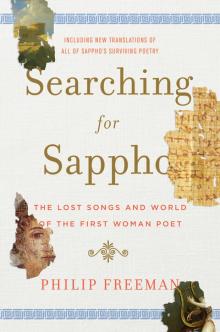 Searching for Sappho
Searching for Sappho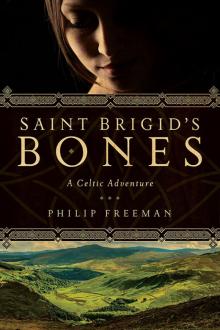 Saint Brigid's Bones
Saint Brigid's Bones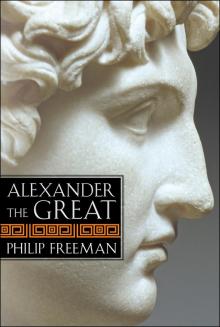 Alexander the Great
Alexander the Great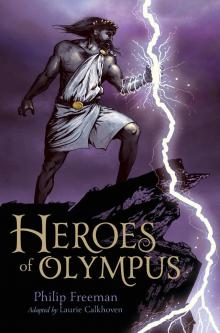 Heroes of Olympus
Heroes of Olympus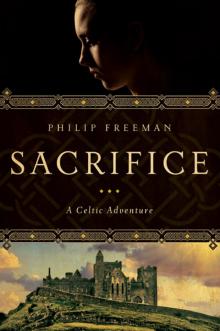 Sacrifice
Sacrifice